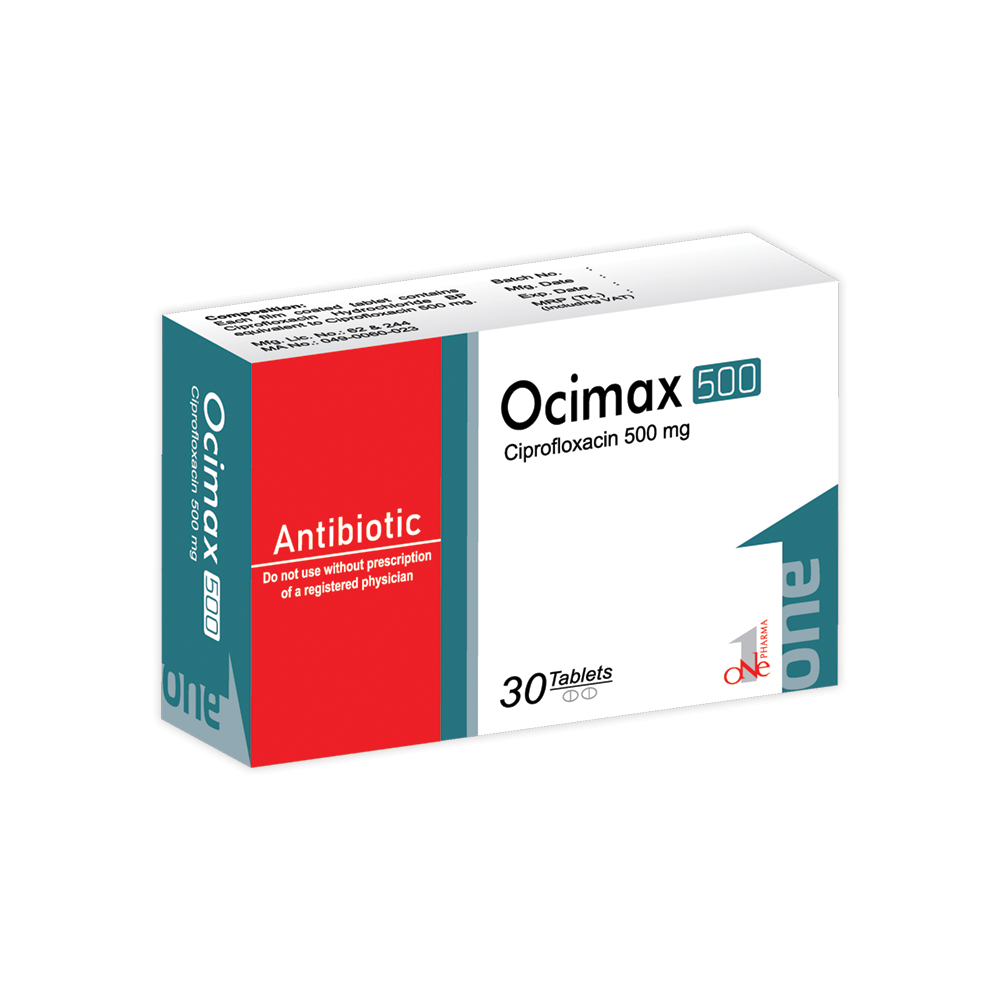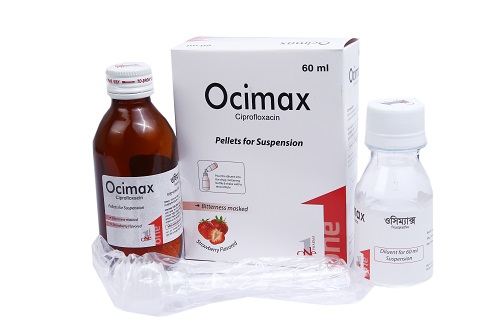



Composition
Ocimax 500 Tablet: Each film coated tablet contains Ciprofloxacin Hydrochloride BP equivalent to
Ciprofloxacin 500 mg.
Ocimax Suspension: Each 5 ml suspension contains Ciprofloxacin USP 250 mg.
Pharmacology
Ciprofloxacin is a synthetic 4-quinolone derivative with bactericidal activity against a wide range of
gram-positive and gram-negative organism. It is active against most gram-negative aerobic bacteria
including Enterobacteriaceae and Pseudomonas aeruginosa. Ciprofloxacin is also active against
gram-positive aerobic bacteria including penicillinase producing, non-penicillinase producing and
methicillin resistant Staphylococci. However many strains of Streptococci are relatively resistant to
the drug. The bactericidal activity of Ciprofloxacin results from interference with the enzyme DNA
gyrase needed for the synthesis of bacterial DNA. The mode of action of Ciprofloxacin is different
from other antibiotics like penicillins, cephalosporins, aminoglycosides, tetracyclines and for this
reason it is observed that organisms resistant to these antibiotics are susceptible to Ciprofloxacin.
Ciprofloxacin is well absorbed from the GIT after oral administration and it is widely distributed into
the body tissues and fluid. The half-life of Ciprofloxacin is 3.5 – 4.5 hours. About 30-50% of an oral
dose of Ciprofloxacin is excreted in the urine within 24 hours as unchanged drug and active
metabolites.
Indication
Ciprofloxacin is indicated for the treatment of the following infections caused by sensitive bacteria:
Severe systemic infections: e.g; septicemia, bacteremia, peritonitis, infections in immunosuppressed
patients with haematological or solid tumors and in patients in intensive care unit with specific
problems such as infected burns.
Respiratory tract infections: Lobar and broncho pneumonia, acute and chronic bronchitis and
empyema.
Urinary tract infections: Uncomplicated and complicated urethritis, cystitis, pyelonephritis, prostatitis
and epididymitis.
Skin and soft tissue infections: Infected ulcers, wound infections, abscesses, cellulitis, otitis externa,
erysipelas and infected burns.
Gastrointestinal infections: Enteric fever, infective diarrhea.
Infections of the biliary tract: Cholangitis, cholecystitis, empyema of the gall bladder.
Intra-abdominal infections: Peritonitis, intra abdominal abscesses.
Bone and joint infections: Osteomyelitis, septic arthritis.
Pelvic infections: Salpingitis, endometritis, pelvic inflammatory diseases.
Eye, ear, nose and throat infections: Otitis media, sinusitis, mastoiditis, tonsillitis.
Gonorrhoea: Urethral, rectal and pharyngeal gonorrhoea caused by beta-lactamase producing
organism or organisms moderately sensitive to penicillin.
Dose and Administration
Route of administration: Oral
Adult:
* use in conjunction with metronidazole
Contraindications
Ciprofloxacin is contraindicated in patients who have hypersensitivity to Ciprofloxacin or other
quinolones.
Warning & Precautions
Ciprofloxacin should be used with caution in patients with a history of convulsive disorders.
Crystalluria related to the use of Ciprofloxacin has been observed only rarely. Patients receiving
Ciprofloxacin should be well hydrated to avoid excessive alkalinity of the urine.
Side effects
Common: Ciprofloxacin is generally well tolerated. Frequent adverse reactions are- Gastrointestinal
disturbance: e.g. nausea, diarrhea, vomiting, dyspepsia, abdominal pain. Disturbance of the CNS:
e.g. dizziness, headache, tiredness, confusion, convulsions. Hypersensitivity reactions: e.g. skin
rashes, pruritus, and possible systemic reactions.
Rare: Joint pain, light sensitivity, transient increase in liver enzyme (especially in patients with history
of liver damage), serum bilirubin, urea or serum creatinine. Arthralgia, myalgia and risk of retinal
detachment.
Use in Pregnancy and Lactation
Reproduction studies performed in rats and rabbits using parenteral and oral administration did not
reveal any evidence of teratogenicity, impairment of fertility or impairment of pre or postnatal
development. However, as with other quinolones, Ciprofloxacin has been shown to cause
arthropathy in immature animals and therefore, its use during pregnancy is not recommended.
Studies in rats have indicated that Ciprofloxacin is secreted in milk, administration to nursing
mothers is thus not recommended.
Use in Children and Adolescents
RTI & GI infections: Neonate-15mg/kg twice daily, Child (1 month -18 years)-20mg/kg (max 750 mg)
twice daily; UTI: Neonate-10 mg/kg twice daily, Child (1 month -18 years)-10mg/kg (max 750 mg)
twice daily; Pseudomonal lower respiratory tract infection in cystic fibrosis: Child (1 month -18 years)
– 20mg/kg (max 750 mg) twice daily; Anthrax (treatment & post exposure prophylaxis): Child (1
month -18 years) – 20mg/kg (max 750 mg) twice daily.
Drug interactions
With Medicine: Concurrent administration of Ciprofloxacin with theophylline may lead to elevated
plasma concentrations of theophylline. Plasma level of theophylline should be monitored and dosage
adjustments made as appropriate. Antacid containing magnesium hydroxide or aluminium hydroxide
may interfere with the absorption of Ciprofloxacin & concurrent administration of these agents with
Ciprofloxacin should be avoided. Probenecid interferes with renal tubular secretion of Ciprofloxacin
and produces an increase in the level of Ciprofloxacin in the serum. As with other broad spectrum
antibiotics prolonged use of Ciprofloxacin may result in over growth of non-susceptible organisms.
Repeated evaluation of patient’s conditions and microbial susceptibility testing is essential. If
superinfections occur during therapy, appropriate measure should be taken.
With food & others: Ciprofloxacin should not be taken concurrently with milk or other dairy products,
since absorption of Ciprofloxacin may be significantly reduced. Dietary calcium is a part of a meal,
however, does not significantly affect the absorption of Ciprofloxacin.
Overdose
Overdose following Ciprofloxacin administration may lead to seizures, hallucinations, confusion,
abdominal discomfort, renal and hepatic impairment as well as crystalluria, haematuria, & reversible
renal toxicity.
Information for patients
Ocimax should be swallowed whole with an adequate amount of liquid, it may be taken with or
without meals. The preferred time of dosing is two hours after a meal and patients should not take
antacid within two hours of dosing.
Storage
Store below 30° C temperature and cool and dry place, away from light. Keep out of the reach of
children.
Packing
Ocimax 500 Tablet: Each box containing 3×10’s tablets of Alu-PVC blister.
Ocimax Suspension: Each box contains one bottle of diluent & one bottle of Ciprofloxacin pellets
with dropper. After reconstitution as per direction bottle contain 60 ml suspension